Text

Resources: Continental Heathenry / German Folk Practice
A scrabbled-together quick list of resources I like for anyone interested in german folk magic & continental heathenry. This is not Norse paganism. While the Germanic tribes and regions overlapped, 'Germanic' is a language family and not one monolithic culture. Continental Germanic practices are an overlooked and undersung path in neopaganism but hopefully we can change that.
--vetted sources! no frith with facists--
Creators:
German Folkwitchery - Down Holle's Well (podcast) (spotify link)
A Hearth Witch (yt) (linktree)
HexMarie (tiktok) (linktree) (tweeter)
De Spökenkieker (yt)
Nordic Animism (yt) (Norse, but great content and many concepts apply to any Germanic practice)
Ella Harrison (yt) (Wiccan -> German folk witch)
Deities
Map: Gods of Gaul and Britain
Map: Pagan European Gods (make sure to check and uncheck the boxes)
Frau Holle, or Holda by @ivy-kissobryos (honestly one of the best Holda posts I've found)
Holda's Shrine
Who is Frau Holle?
Berchta: Ancient Alpine Goddess of Women, Children, and the Perchten (cannot vouch for blog but good intro by someone who works with Berchta)
The Matronae
Donar (jackson crawford, yt link)
Wodan (jackson crawford, yt link)
(My fav resources on Donar and Wodan from a practitioner perspective are from A Hearth Witch's patreon so I will not be sharing her content, I unfortunately can't find excellent free webpage resources)
Sirona
Nerthus (good post for historical pagan info)
Nerthus (cannot vouch for the blog but another post)
Hearth Cult Guide (The Longship)
General Resources
The Longship: A Beginner's Guide to Heathenry
Gaulish Polytheism
Sidjus Reidarje Sauilis: A Tradition of Gothic Heathenry
Nemeton Eluêtion (Helvetii Tribe of Gaul and the Ancient Swiss People)
Map: German Folklore
Map: Pagan Sites in Germany and the Netherlands
What Is Rauhnact
No Frith With Facists: DNI List
This is in no way an all-inclusive list. This is a collection of online resources I'm aware of and have been learning from. I am not an authority.
201 notes
·
View notes
Text

Poem for Earth Day. From Matthew Olzmann's book, Constellation Route. (Alice James Books, 2022)
#i strongly disagree with this poem#but couldnt decide on the best reply from the notes to reblog#so i'm mostly reblogging this in frustration#maybe i'll come back to it with a real addition sometime#poetry
11K notes
·
View notes
Text
some loser: humans are innately selfish creatures
my psych book:

58K notes
·
View notes
Text
feel free to reblog or comment why !
#yes#there are people who say ''i am spiritual but not religious''#i am closer to the opposite#i do religion even tho i do not know for sure if the gods are real#even if i rarely have spiritual experiences since leaving mormonism#because doing religion feels right
51 notes
·
View notes
Text
Remember when historian Diane Purkiss chose violence? 🤣
“In this essay, I will show that medieval and early modern witchcraft was for the most part not a pagan practice, but a dissident form of Christianity. I will also argue that modern pagans and modern witches are themselves products of the very globalized, commercial, urban and anywhere culture which they set out to resist.”
276 notes
·
View notes
Text
I'm considering moving my religious stuff onto my main account. I created an entirely different account for this blog because I thought it would be nice to have a focused place and dash for religious things, but as it turns out.
And I still think there's value for that. I'm considering moving to a side-blog of the main account so that it doesn´t mix in with my normal stuff. It's also certainly easier to keep up with dashboard posts on this account, since I follow far fewer people here. (Everyone I follow on this account would be swallowed up by the 100s of non-religious blogs I follow on main).
However, the main result of having the religious blog on a separate account is that I never end up logging into it. On desktop, this is mostly solved by Firefox container tabs, but because I'm gone most of the day, I'm usually on the mobile app, which is actively annoying to sign out of and into, since it involves logging out, copying a password from a password manager, logging in, and resetting all my mobile settings every time I do that (in addition to losing notifs to the acct I'm logging out at).
0 notes
Text
Hello Hellenic polytheists, deanists, pagans in general, and anybody else interested! I run Awful & Lovely, a submission-based online shrine to the Greco-Roman goddess Aphrodite/Venus. This blog was inspired by a 2017 Getty Villa project-- the museum hosted a shrine to Venus where visitors could leave prayers, wishes, and gifts for the goddess.
In the spirit of the original project, this blog is meant to be both a resource for Aphrodite worshipers to leave offerings, as well as being a unique experience for non-pagans. The blog hasn't gotten much traffic since I started it, but with so many Aphrodite/Venus devotees on this site, I feel like a lot of you would get good use out of it, so I'm blazing this post to try and get the word out. Please take a moment to drop by the blog, and maybe leave a word of praise for the "beautiful and comely" goddess!

252 notes
·
View notes
Text
Baragion dagon! I would like to share a project @uailogenos and I worked on, we have taken a song that was special to each of us and made it relevant to our paths. We dedicate this project to Đironâ and Nantosueltâ.
youtube
Dêwoi co te!
7 notes
·
View notes
Text
Another idea for bloodless animal offerings
Occasionally I have *ideas* and that’s just one of them. By now you all know I’m a fan of clay offerings, but they’re effort and making a clay animal a long process and can be difficult.
And then I remembered those exist:

I remember seeing those premade papier mache animals and other stuff in my local craft store and I feel so stupid for not thinking about this earlier because they would make such good offerings. They tend to be on the cheaper side, you can paint them or cover them with pretty paper and bam. You have a quick and easy animal figurine to offer without the long and intricate process of making/sculpting it yourself.
312 notes
·
View notes
Text
@bruxtia mentioned a statue found of a (perhaps) female version of Cernunnos. Which reminded me that I actually wrote a piece about that in 2020 but never shared here.
Cernuna?
I got a question on Twitter by a follower who wondered if I have any information about the Goddess Cernuna. I must admit, I’d read the name once in passing, while reading about Cernunnos, but I never really dove further into it, thinking that it was simply a modern pagan’s wishful thinking. After the question, however, I got curious. Is there a female counterpart to Cernunnos? Do we have evidence of a Gaulish female antlered Goddess?
Short answer: sort of.
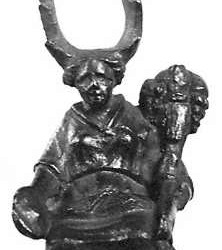
Above is a bronze statue of an antlered woman, sitting crosslegged, holding a cornucopia and a patera: a gallo-roman offering dish. The statue is currently in the British Museum, but was found at Broye in the Haute-Saône (Franche-Comté). Interesting is of course that she had antlers, and the fact that she is sitting cross-legged, something that most Cernunnos depictions have as well.

Another antlered goddess, sitting cross-legged, holding a cornucopia was discovered in Puy-de-Dôme. Her other hand is empty but was likely holding another patera. She can be seen in the Musée de Clermont-Ferrand.
The cornucopia is a symbol of abundance and prosperity. The patera is one of worship, of leaving offerings for a deity. However, often the figures holding the patera would not be the deity themself, but those who would bring offerings to them. So are we looking at statues of Goddesses, or of priestesses? Horns (or antlers) indicate a link to nature and the hunt. Which would make these potential Goddesses a Goddess of nature, the hunt, and abundance (and perhaps the harvest).

Photo by Alexander Schimmeck on Unsplash
There is also mention of a relief of a horned (not antlered) Goddess found on a piece of pottery in Richborough, Kent, but I wasn’t able to find an image of this.
Of course we know next to nothing about these figures. Their name, or what their attributes entailed. Cernuna or Cernunna would be a suitable name, meaning “horned” but whether or not She would have a link to Cernunnos is impossible to know. And if She did have a link to Cernunnos, what would it be? Is She His consort, His wife, His sister, His female form? An interesting concept to think about.
Sources:
We Are Star Stuff – Cernunnos
We Are Star Stuff – Horned Goddesses
DeoMercurio – Cernunnos
Noémie Beck – Goddesses in Celtic Religion
Ceisiwr Serith – Cernunnos: Looking a Different Way
Sharon Paice MacLeod – Celtic Cosmology and the Otherworld: Mythic Origins, Sovereignty and Liminality pg. 152-154
Miranda Green – Symbol and Image in Celtic Religious Art pg. 26-27
Miranda Green – Animals in Celtic Life and Myth pg. 237
Georgia Irby-Massie – Military Religion in Roman Britain pg. 100
50 notes
·
View notes
Note
I didn't want to bother you, but since you said to another anon you're glad to receive asks, I guess I'll jump in :D!
I'm a bit of a newbie, and from what I've seen, there seem to be a lot of controversy about which god was the main god of war/Martian-ish god. Any insight? Also, do you have anything in store about Taranis 👀?
Thank you so much for your blog!
Hey, awesome!
There is no concept of a main god of war or a centralized pantheon in Gaulish Polytheism , which can be complicated when approaching Gaulpol initially from the lens of another polytheistic tradition where those things do exist.
Gaul was not a centralized region, people, religion, culture, language, none of that, we're dealing with an umbrella term for many different nations and tribes over a massive period of time where populations shifted and so many different outside variables have introduced the people, language, religion, and culture. There is no hard line where Gaulish religion starts or ends, geographically or chronologically, no strict definition defines Gaul or Gaulish Polytheism.
As a result, especially in a region where warfare between tribes was a typical endeavor, either as contests of champions or full-scale conflict, war deities played a massive amount in daily life. You'll have gods with war aspects but also were known for a variety of things as well. Camulos is a war god, but also a protector of tribal boundaries. Brigantia also has strong war associations but also is associated with the hearth. Every Toutatis, tribal god of a nation\people who associated themselves with a common origin, would also serve as their personal war deity as well.
The gods of Gaul fit far less in stereotypical roles seen in the more popular polytheistic traditions and often personal relationships are further emphasized when looking for a deity to ask for assistance or invoke in ritual for a specific reason.
Hopefully this all makes sense, I feel like I ranted a bit.
As far as Taranis, check out SR's Taranos page if you've not already https://followersofthewheel.org/taranos/
Not necessary planning any new article or presentation on Him in the short term. We've just released a big comparative mythology video regarding Taranos as a bull who slays a dragon which can be found on the Touta Galation youtube. But Taranis is pretty popular so there's always more reconstruction and revivalism being done regarding His cultus.
11 notes
·
View notes
Text
[grabs your shirt] listen. listen to me. the practical is holy. the everyday is sacred. the simple act of surviving is divine. do you get it? sanctity begins at home, in the hands that build and the lives we live and the deaths we die and the worms that eat our bodies. if making something by hand is not worthy of veneration then nothing is.
69K notes
·
View notes
Note
Hey! I saw you responded to some asks and I thought I'd give it a try myself (it's ok if you don't answer though).
I was just wondering what are your thoughts on Lugus? do you have any experiences with him? What does he represent?
Hey there! Thank you so much.
This is a great question. I've personally had minimal interactions with Lugus myself, but I've seen many examples of others' interactions with Him, so brief warning it's a lot of gnosis mixed in.
He's a warband leader, and feels like a younger generation of god compared to the more primal beings like Taranos and Belinos, Lugus is instead a god of culture, a god of the people. His association with the Irish god Lugh has brought in the aspect of being the many-skilled, and while historically that seemed to be focused on His marital ability, in Gaulpol there are many other martial and gods of war yet no true patron of the arts so instead Lugus is often seen in that role, as the "renaissance man" among the gods, skilled in many crafts and art.
To me, He represents the new generation that surpasses the old, not in spite of them, but because of them. He represents the flexibility, adaptability, the ability to learn, grow, and to hone our bodies and minds as humans.
16 notes
·
View notes
Text


The Compitalia, a Roman festival held between January 1-5 each year, honors the Lares Compitales, guardians of the crossroads and, by extension, the surrounding neighborhood.
Compital shrines were sometimes simple frescoes or stone altars, though stone buildings are known to have been built for the purpose. The shrines were often the focus of the surrounding community during the year, places where news and gossip were shared and where wedding parties would pause for the newlyweds to leave coins or other offerings to the Compital Lares on the way to their new home.
This festival was administered by magisteri vici and ministeri vici, local government offices held by freedmen and slaves respectively. Because this festival was based in neighborhoods and rural communities, the simplicity or grandeur of the celebration varied with the wealth of the inhabitants and the aspirations of the office-holders.
Common to this celebration at every level of society was the garlanding of the Compital shrine with flowers. The doorways of houses and the Compital shrine itself were also decorated with balls and and anthropomorphic figures of wool, which perhaps served an apotropaic function. There was a procession to the Compital shrine in the morning, with offerings of honey cakes by each household and usually a sacrifice of an animal or animals. This was followed by a block party with entertainment, music and dancing, perhaps plays, contests, and/or gladiatorial combats.
╚═══════════════╗⋆✧⋆✦⋆✧⋆╔═══════════════╝
Featured image: A fresco depicting Roman men wearing the toga praetextae participating in a religious ceremony, perhaps the Compitalia. It was discovered at the archaeological site of Moregine, along the Sarno River just south of Pompei during road maintenance. The area was reburied due to the high water level and resulting cost of preservation.
Image source: https://commons.wikimedia.org/wiki/File:Compitalia_fresco.jpg
Image license: Public domain. I adjusted the sharpness and color and made the cropped detail image.
22 notes
·
View notes
Text

Saturnalia is an ancient Roman religious festival honoring Saturn, who was pardoned after his expulsion from Olympus by Jupiter and subsequently regarded as a benevolent god of agricultural abundance.
The first documented Saturnalia was held in 497 BCE for the dedication of the Temple of Saturn in Rome. An annual festival commemorating the dies natalis (anniversary) of this event was thereafter held on December 17. The celebration proved so popular that it was extended to three days, then to an entire week, from December 17 to 23. There was a 24 hour break to take care of home and business - and then everyone went back to celebrating with the dies natalis of Sol Invictus on December 25!
The Saturnalia recalled the mythical Age of Saturn, when crops grew without human toil and humanity lived in harmony with nature and each other. Elements of the festival included days off from work, gatherings of family and friends, wearing brightly-colored garments, preparing and indulging in copious amounts of food and drink, playing games, attending theatrical and musical performances, giving gifts, decorating homes and businesses with garlands and wreaths of evergreens gleaming with sparkly ornaments, light from candles, lamps, torches, and bonfires - all of which probably sound at least a little bit familiar!
The reversal of normal societal roles was emblematic of Saturnalia: the emperor bestowed largess upon soldiers and the populace, employers gave bonuses to workers, families with the means to do so gave food and clothing the poor, owners served their slaves and the wealthy waited on their servants, children were allowed to attend theatrical performances and to gamble.
The traditional greeting during this celebration is “Io, Saturanalia!” (Io is pronounced ”ee-o” or “yo”).
If you're able to do so, I hope you will continue the Saturnalia tradition of gifts and role-reversals by supporting your local food bank, shelter, and/or warming center.
༺*⌎° •.✨⋅ ✧ ⋅*⋅ ✶ ⋅*⋅ ✧ ⋅*⌎° •. 🌟 .• °⌏*⋅ ✧ ⋅*⋅ ✶ ⋅*⋅ ✧ ⋅✨.• °⌏*༻
206 notes
·
View notes
Text



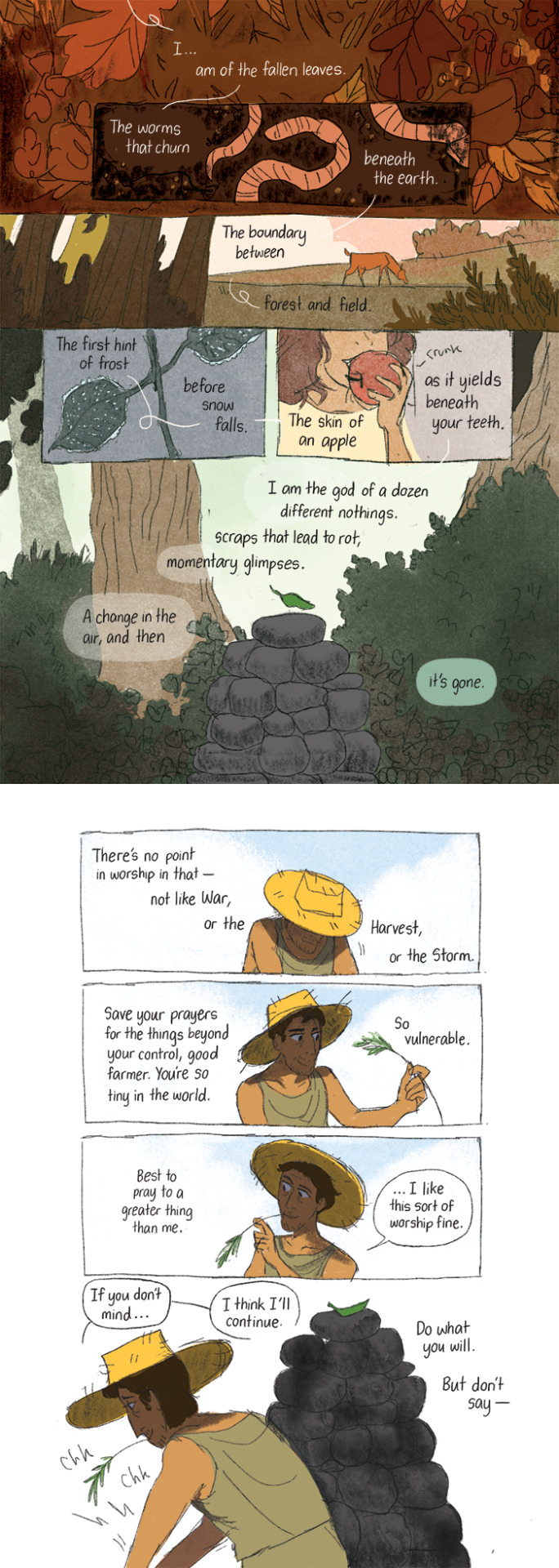

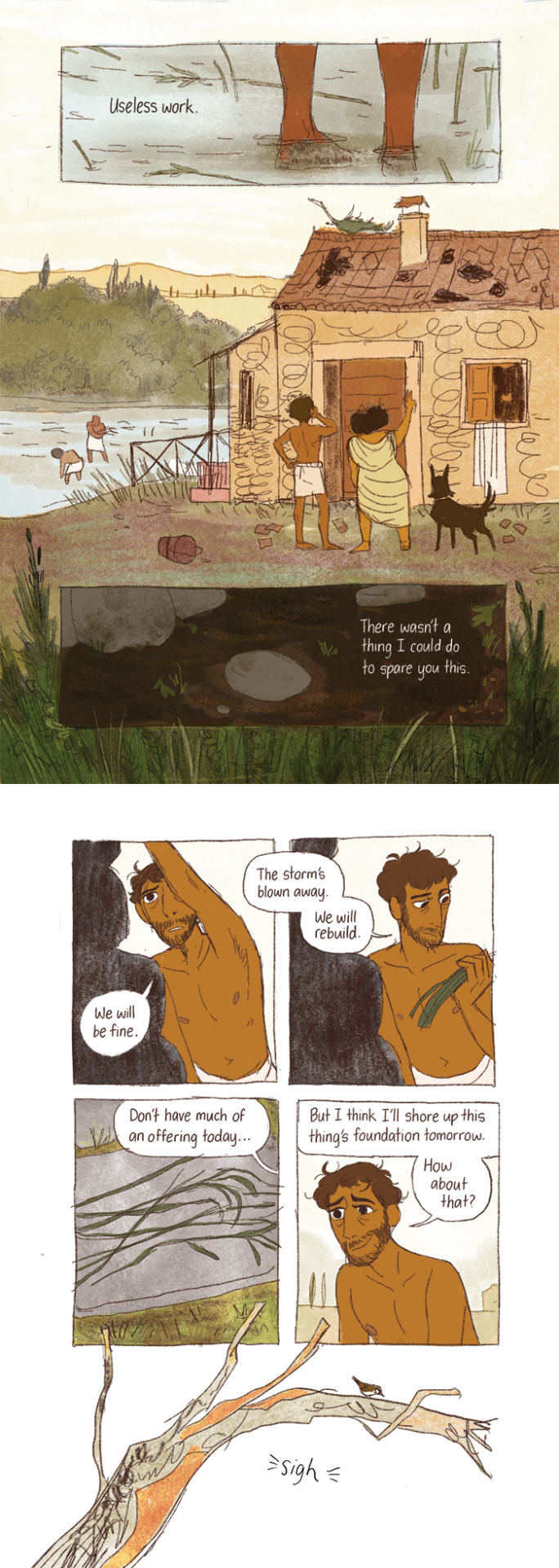

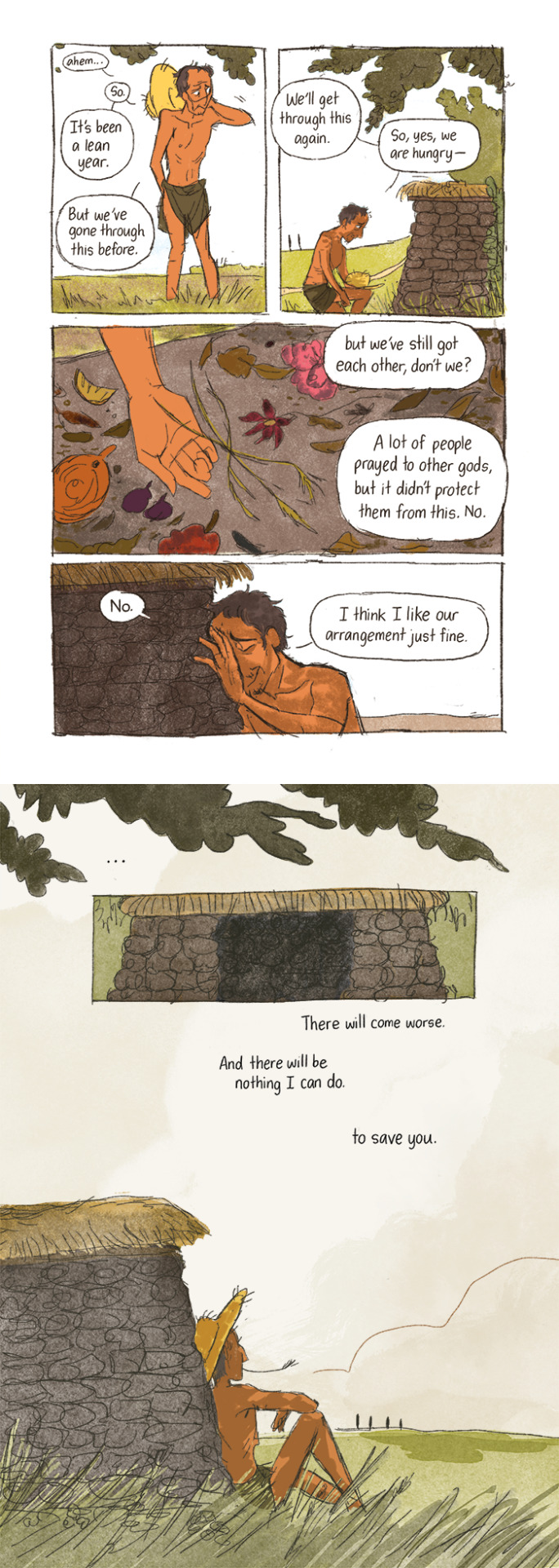








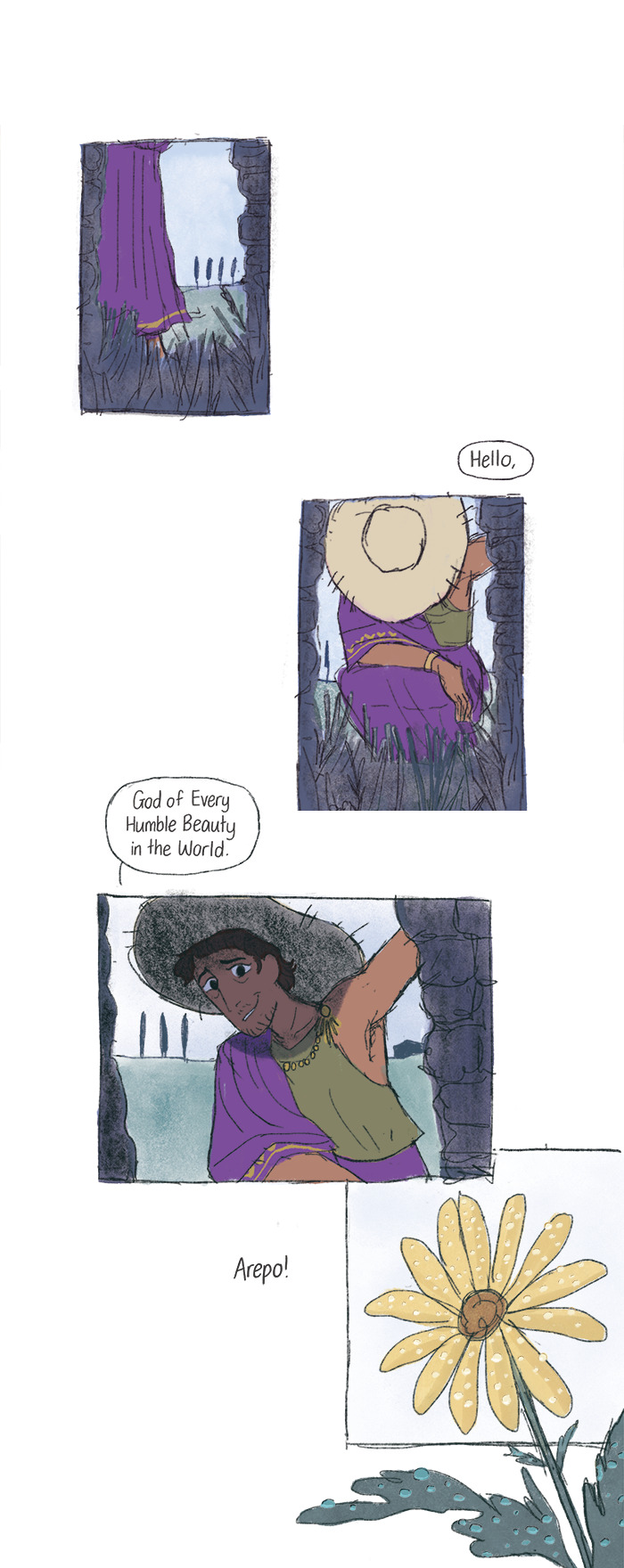
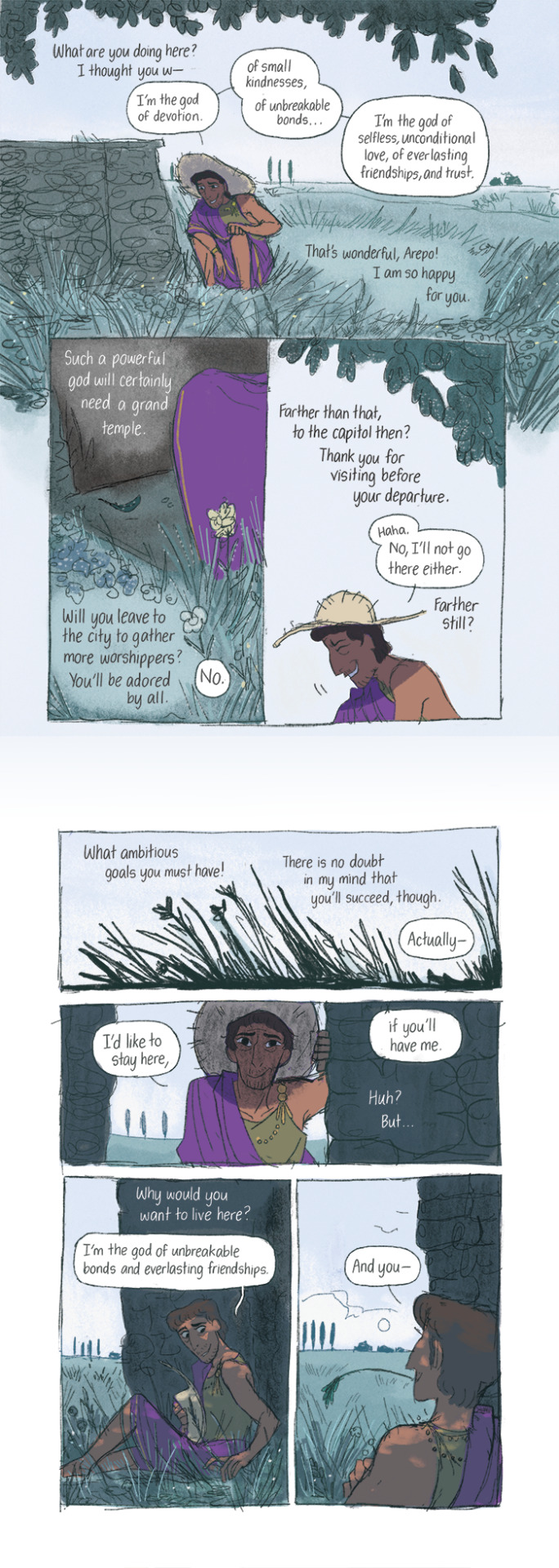

My adaptation of the God of Arepo short story, which was originally up at ShortBox Comics Fair for charity. You can get a copy of the DRM-free ebook here for free - and I'd encourage you to donate to Mighty Writers or The Ministry of Stories in exchange.
Again it's an honour to be drawing one of my favourite short stories ever. Thank you so much for the original authors for creating this story; and for everyone who bought a copy and donated to the above non-profits.
90K notes
·
View notes